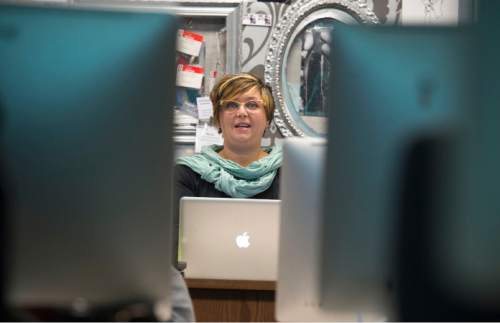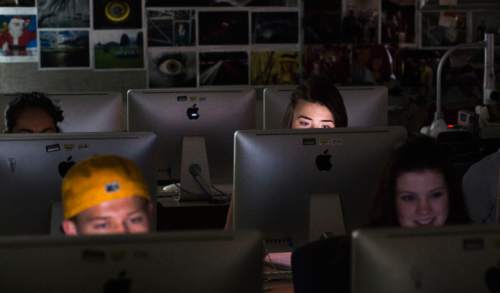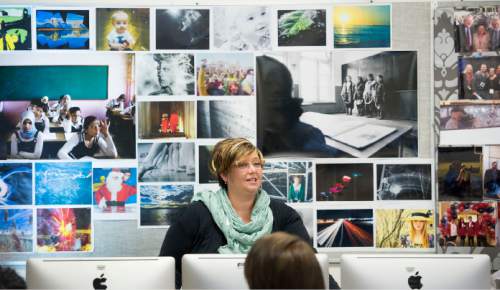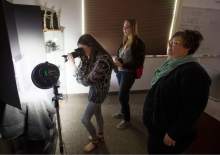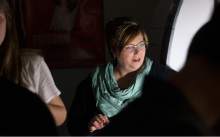This is an archived article that was published on sltrib.com in 2015, and information in the article may be outdated. It is provided only for personal research purposes and may not be reprinted.
Editor's note • This is the fourth in a five-part series about Utah educators given Teacher Innovation Awards this year for their use of technology in classrooms.
American Fork • Taylor Maag sits next to Wendy Frazier-Snyder and tells how he got the shot the weekend before.
He trudged along a snow-closed road in the Uinta Mountains, climbed two miles up to a ridge, and then waited for the Milky Way to rise at 3:30 a.m. He had two cameras, both shooting still shots that he would later edit into a time-lapsed video — the one he's now showing Frazier-Snyder.
"Wow," says Frazier-Snyder, a photography teacher at American Fork High. "Not everybody does this."
Maag has something similar to say about Frazier-Snyder.
"A lot of other teachers, they work en masse," Maag says. "She's willing to work with students one on one. That's the one thing students need."
Frazier-Snyder is one of five teachers selected for this year's Teacher Innovation Awards, sponsored by KUED and The Salt Lake Tribune. The five will be honored at a banquet Saturday, and KUED will air a half-hour program profiling the five teachers at 8 p.m. Monday.
Frazier-Snyder has been teaching digital media for 10 years at American Fork High, and English before that.
She teaches everything from how to make good images by controlling the camera's aperture to using software such as Photoshop and Illustrator. Her classes are part of the Careers and Technical Education curriculum, designed to give students skills they can immediately put to use in the marketplace.
Frazier-Snyder has no illusion that the 150 students she teaches each semester will go into photography or digital design, but knows such skills are useful in many industries now.
And she assumes that some, such as Maag, will make it a career.
"I need to give them the tools, but the creativity part is theirs," says Frazier-Snyder. "I want to give them a taste of what could be."
—
The cutting edge • Frazier-Snyder was raised in Los Angeles and started college at Brigham Young University-Hawaii. After her parents moved to Utah, she switched to the University of Utah and took a few photography classes, but earned a degree in English and education.
She taught two years at a junior high, which didn't go so well. Next she tried her hand as a photographer in Los Angeles, shooting for a four-wheeler magazine.
That was about the time that digital cameras replaced film in most of photojournalism.
Burned out on the pace — and the low pay — she returned after a couple of years to teaching, this time English at American Fork High.
School administrators first asked her to teach one digital-photography class, then another and another. It became her full-time job about a decade ago.
If Maag, her student, believes Frazier-Snyder's true talent is her willingness to work individually with students, Doug Golding sees it as her embrace of all that's new.
Golding is the director of the Alpine School District's Careers and Technical Education program.
"When it comes to innovation," Golding says, "she's way out there."
She collaborates with the software company Adobe extensively, he notes.
Frazier-Snyder is one of two Adobe Youth Voices lead educators in Utah and was able to get the company's software for her students even before the district got a site license for its use, Golding says.
Her lab, which Frazier-Snyder estimates has $80,000 worth of computers, cameras and software, is equipped so well because she asks for it to be, Golding says.
"I don't go into the lab and say, 'I'm going to give you this.' I wait for the teacher to say, 'I can use this and this and this, and I've gone to the training to use it,' " he says.
Frazier-Snyder's students, Golding says, "are getting a world-class type of experience in her class because of her innovation."
—
The big picture • Maag says he had been using a GoPro since age 13, shooting mostly snowboarding videos, before he took Frazier-Snyder's class in the winter of 2014. Now 18, he will graduate this month.
"She pretty much helped me with everything," he says. "I'd never opened Photoshop in my life. I came in here, opened it up and said, 'What the crap is this?' "
Soon Maag started borrowing top-of-the-line equipment from Frazier-Snyder's lab and taught himself to shoot the night sky.
"He'll say, 'I'm going camping tonight. Can I borrow this?' and he does these amazing things," says his teacher.
"I taught him the basics, but he ran with it."
Tanner Roberts, also 18 and graduating, says Frazier-Snyder "knows everything there is to know about a camera."
On a recent spring morning, he and his classmates were shooting "science-y" photos of dripping paint and red, green and yellow peppers falling into a water tank.
Roberts says he doesn't see himself pursuing photography as a career. But Frazier-Snyder's photography class has changed how he looks at the world.
"I was over at my friend's the other night and I said, 'Whoa, the stars are cool! Hold on, let me take a picture. Let me use a long shutter speed and small aperture to make the stars pop,' " says Roberts.
"I look at things differently. It's changed my perspective on things. I'm taking pictures all the time in my mind now."
Twitter: @KristenMoulton


